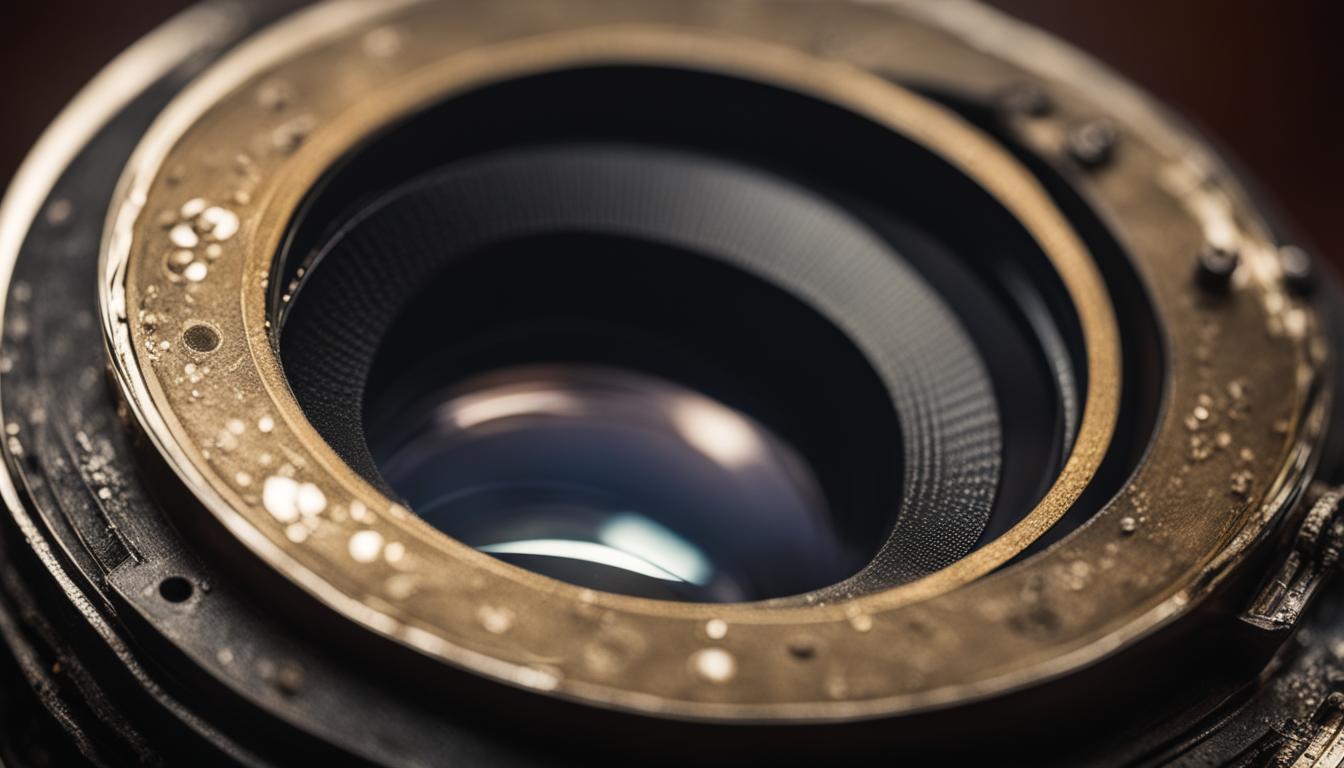Welcome to our exploration of the fascinating history of photography! Throughout the years, photography has undergone a significant transformation, from the early days of Daguerreotypes to the modern era of digital photography. Let’s take a journey through time and discover the evolution of this art form.
It all began with Louis Daguerre, a French artist who invented the Daguerreotype process in 1839. This new technique allowed for the creation of unique and highly-detailed images on silver-plated copper plates. The first photograph ever taken, “View from the Window at Le Gras,” was captured using the Daguerreotype process.
From there, photography continued to evolve and advance, with innovations like the wet plate collodion process, the introduction of roll film, and the standardization of 35mm film format. Eventually, the advent of digital photography transformed the field once again, with the rise of image editing software, mobile photography, and more.
Join us as we explore the rich history and ongoing evolution of photography, from its earliest roots to its exciting future possibilities.
Key Takeaways:
- The invention of the Daguerreotype process by Louis Daguerre marked the birth of photography.
- The wet plate collodion process revolutionized photography in the mid-19th century.
- The introduction of roll film made photography more accessible and convenient.
- 35mm film became the standardized format for professional and amateur photography.
- The advent of digital photography transformed the field and enabled new forms of expression.
The Birth of Photography: Daguerreotypes and the First Photograph
Welcome to the fascinating story of the birth of photography. This section will take you on a journey back to the early 19th century, when the idea of capturing visual images on a surface was nothing more than a dream.
Then came along Louis-Jacques-Mandé Daguerre, a French artist and inventor, who revolutionized the field with his groundbreaking invention of the daguerreotype process. The daguerreotype was an early photographic process that involved exposing an image onto a silvered copper plate.
The first practical daguerreotype was produced in 1837, and it paved the way for a new era of visual art. One of the most famous examples of early photography is the “View from the Window at Le Gras,” taken by Joseph Nicéphore Niépce in 1826. The photograph was an eight-hour exposure taken from his window and is recognized as the world’s first photograph.
The daguerreotype process became increasingly popular throughout the 1840s and 1850s, with photographers using it to capture everything from portraits to landscapes. It was a complex process, involving the use of a camera obscura to project an image onto a plate coated with light-sensitive chemicals.
“The daguerreotype is not merely an instrument which serves to draw nature…it gives her the power to reproduce herself.” – Louis Daguerre
The daguerreotype process paved the way for the modern photography we know today. It was the first practical method of photography and set the stage for the development of other photographic processes, such as the wet plate collodion process and roll film.
Wet Plate Collodion Process: Advancement in Photography
The late 19th century saw a major leap in photography’s evolution with the introduction of the wet plate collodion process. This revolutionary technique replaced Daguerreotypes and allowed photographers to capture sharper, more detailed images. The process involved coating a glass plate with a light-sensitive mixture of collodion, a nitrogen-based compound, and a salt solution. The plate had to be exposed and developed while still wet, making the process challenging and time-consuming.
Despite its difficulty, the wet plate collodion process quickly became popular among photographers due to its many advantages. For one, it produced sharp, detailed images that were superior to those produced by earlier processes. The fact that the plates could be developed immediately also made it possible to take photographs in the field.
To capture images with this process, photographers had to carry a portable darkroom with them. The equipment needed included a camera with a lens, a tripod, a glass plate holder, and chemicals for developing the plate. The process required great skill and patience, but it also opened up new possibilities for photographers to capture images in situ.
One notable aspect of the wet plate collodion process was its popularity among Civil War photographers. The process allowed them to document the war in ways never before possible, capturing vivid images of battlefields, soldiers, and other wartime scenes.
The wet plate collodion process was eventually replaced by other techniques, such as dry plate photography and roll film. However, its impact on the evolution of photography cannot be overstated. This technique paved the way for advancements in photographic equipment and techniques, and it helped transform photography from a rare and expensive hobby into a widely accessible form of expression.
“The wet plate collodion process paved the way for advancements in photographic equipment and techniques, and it helped transform photography from a rare and expensive hobby into a widely accessible form of expression.”
From Film to Roll: The Introduction of Roll Film
Film photography has come a long way since its early days, with technological advancements improving the accessibility and convenience of the medium over time. One of the key developments in this regard was the introduction of roll film, which replaced large-format film and made photography more accessible to the masses.
Roll film was first introduced in 1881 by George Eastman, the founder of Kodak. The technology involved replacing individual glass plates with a spool of flexible film that could be wound around a roller. This allowed photographers to take multiple shots without having to replace plates after each exposure.
The introduction of roll film not only made photography more convenient, but also paved the way for the emergence of popular camera brands like Kodak and Leica. Kodak’s Brownie camera, introduced in 1900, was one of the first cameras designed to use roll film and became hugely popular among amateur photographers.
| Advantages of Roll Film | Disadvantages of Large-Format Film |
|---|---|
|
|
These advantages made photography more accessible to a wider audience, democratizing the medium and allowing for greater experimentation and creative expression. It also paved the way for further innovations in film technology and the eventual transition to digital photography.
“Roll film was a major step forward in making photography more accessible to the masses, and paved the way for the emergence of popular camera brands.”
The Rise of 35mm: Standardization of Film Format
The 35mm film format introduced by Oskar Barnack in 1913 revolutionized photography by providing a smaller, more portable alternative to large-format film. However, it wasn’t until the 1930s that the 35mm format became standardized, thanks to the introduction of the Leica Standard Camera.
By the 1950s and 60s, 35mm had become the most popular film format for both amateur and professional photographers. The standardization of the 35mm format meant that photographers could easily switch between different cameras and brands without having to worry about compatibility issues. This allowed for greater flexibility and creativity in the field of photography.
The 35mm format also had a significant impact on the aesthetics of photography. The smaller size of the film allowed for a greater depth of field, resulting in sharper images with more detail. This made 35mm particularly suited to street photography and photojournalism, where speed was of the essence.
However, the rise of digital photography has led to a decline in the use of the 35mm format. Many photographers now prefer the convenience and flexibility of digital sensors, which offer the ability to instantly preview and edit images.
Despite this shift, the legacy of 35mm film lives on in the world of photography. Many photographers still choose to shoot with film for its distinct look and feel, while others have embraced the hybrid approach of using both digital and film technologies.
The Birth of Color Photography: Technological Breakthroughs
Color photography was a monumental breakthrough that opened new horizons in visual storytelling. For over a century, photographers struggled to capture the world’s vibrant hues in their images, using various techniques that fell short of true color reproduction. It was not until the mid-1930s that the first practical color films were introduced, ushering in a new era for photography.
The first commercially successful color process was Kodachrome, developed by two professional musicians, Leopold Godowsky Jr. and Leopold Mannes. Their invention used a complex system of dye layers to produce rich, lifelike colors, far surpassing the limited palettes of earlier processes. The first Kodachrome film was introduced in 1935 and quickly became a favorite among photographers for its sharpness, clarity, and vivid colors.
Other notable breakthroughs in color photography followed, each building on the technological advancements that came before. In the 1940s, Eastman Kodak introduced Ektachrome, a new color reversal film that allowed photographers to create positive images directly from the film. In the 1950s, color negative film became widely available, making it easier to produce prints directly from the film.
The popularity of color photography grew steadily, and by the 1970s, it had become the dominant form of photography. With the advent of digital photography, color reproduction has become even more precise and controllable, allowing photographers to create images with unprecedented accuracy and depth.
Color photography has become an integral part of our visual culture, shaping the way we see and understand the world around us. From the vibrant hues of nature to the richly textured landscapes of cityscapes, color photography captures the essence of our experiences in ways that were once unimaginable.
The Digital Revolution: From Pixels to Screens
In the late 20th century, photography was revolutionized by the advent of digital technology. Instead of film, images were captured by digital sensors which convert light into pixels, digital units of visual information. This shift allowed for greater control over the image-making process and made photography more accessible to a wider audience.
The digital revolution also brought about the rise of image editing software, such as Photoshop, which allowed photographers to manipulate and enhance their images in ways that were previously impossible. The integration of photography with digital devices and social media platforms has also transformed the way we share and consume images.
The rise of digital photography has had a profound impact on the industry, leading to the decline of traditional film and the emergence of new camera technologies and brands. Today, the majority of photographers use digital cameras, from simple point-and-shoot devices to advanced DSLRs, which offer greater flexibility and control.
The digital revolution has also opened up new opportunities for creativity and experimentation, empowering photographers to push the boundaries of traditional photography and explore new forms of visual expression.
From Point-and-Shoot to DSLRs: The Accessibility of Digital Cameras
With the advent of digital technology, photography became more accessible than ever before. Once confined to the realm of professionals and serious hobbyists, cameras evolved to become simpler, more intuitive, and more affordable, opening up new opportunities for creativity and self-expression.
The first digital cameras were relatively basic, with limited functionality and low image quality. However, as technology improved, so did the capabilities of digital cameras. Today, there is a wide range of cameras available, from simple point-and-shoot devices to advanced DSLRs with interchangeable lenses and complex manual controls.
Point-and-shoot cameras are designed for ease of use, with automatic settings and compact size that make them ideal for casual photography and travel. They are affordable and widely available, and many models now feature advanced features like image stabilization and high-resolution sensors.
On the other hand, DSLRs offer a range of manual controls that give photographers more creative flexibility. They allow for interchangeable lenses, which can be customized to suit different shooting situations, and typically have superior image quality and low-light performance. While they are more expensive than point-and-shoot cameras, they are still more accessible than ever before.
The accessibility of digital cameras has had a democratizing effect on photography, allowing anyone with a camera to explore their creativity and share their perspective with the world. It has also created new opportunities for aspiring photographers to learn and develop their skills, with a wealth of online tutorials and resources available at their fingertips.
Mobile Photography: The Camera in Your Pocket
In recent years, mobile photography has emerged as a dominant force in the photography world. With the ubiquity of camera phones, anyone with a smartphone has access to a powerful and versatile camera that is always at hand.
The rise of mobile photography has been facilitated not only by hardware advancements but also by the emergence of social media platforms such as Instagram. These platforms have provided photographers with an easy way to share their work and connect with others in the photography community.
The convenience and accessibility of camera phones have democratized photography, empowering amateurs and professionals alike to capture and share their vision with the world. Mobile photography has also challenged traditional notions of what constitutes a “good” photograph, emphasizing creativity and spontaneity over technical perfection.
While mobile photography has its limitations compared to traditional cameras, such as the inability to change lenses or control aperture and shutter speed, it offers unique opportunities for experimentation and innovation. Many photographers have embraced the limitations of camera phones as a creative challenge, pushing the boundaries of what is possible with this technology.
Mobile Photography Tips
If you’re interested in exploring mobile photography, here are a few tips to get you started:
- Experiment with different angles and perspectives
- Look for interesting lighting and shadows
- Use editing apps to enhance your photos
- Try shooting in black and white or using filters
- Be creative and don’t be afraid to take risks!
As Chase Jarvis famously said, “The best camera is the one that’s with you.” With camera phones becoming increasingly advanced, there has never been a better time to explore the exciting world of mobile photography.
The Future of Photography: AI, VR, and Beyond
The continued evolution of photography is an exciting prospect, especially in light of the rapid advancement of technology. With the advent of artificial intelligence and virtual reality, photography as we know it is poised for a transformative shift.
AI
Artificial intelligence is already playing a significant role in photography, from image recognition and automated editing to predictive analytics. AI-powered cameras are starting to hit the market, allowing for real-time object detection and automatic adjustments of settings to capture the perfect shot. With the ability to analyze vast amounts of data, including historical photographic trends and user behavior, AI promises to enhance the accessibility and personalization of photography for professionals and amateurs alike.
VR
Virtual reality has the potential to revolutionize the way we capture and experience photographs. With the ability to create immersive 3D environments, VR technology enables photographers to capture even more realistic and detailed representations of the world around us. Additionally, VR headsets provide a unique way to view photographs, allowing users to feel like they are truly inside the image. This type of experience opens up new possibilities for storytelling and creative expression.
As technology continues to advance, the future of photography holds incredible possibilities. From AI-powered cameras and automated editing to virtual reality experiences, the potential for innovation is limitless. It will be fascinating to see how photographers continue to push the boundaries of the medium and explore new forms of creative expression.
Photography as an Art Form: Evolving Perspectives
As photography evolved, so did its perception as an art form. In its early days, photography was seen by many as a mere mechanical reproduction of reality, lacking the creative essence of other art forms. However, over time, photography began to be recognized for its unique ability to capture and interpret reality in new and creative ways.
One of the key developments that pushed photography towards the realm of art was the emergence of modernist movements in the early 20th century. These movements, such as Dada and Surrealism, embraced photography as a means of creating innovative and experimental images that challenged traditional notions of reality and representation.
Since then, photography has continued to push the boundaries of artistic expression. From street photography to conceptual art, photographic techniques and styles have proliferated, each offering unique ways of interpreting and reimagining the world. Moreover, as digital technology has become more integrated with photography, new possibilities for manipulating and transforming images have emerged, leading to even greater creative potential.
Yet, even as photography has gained greater recognition as an art form, debates about its status and value persist. Some critics argue that photography’s mechanical nature and reliance on technology detract from its artistic value, while others view its accessibility and democratic potential as essential to its artistic significance.
“Photography is an art of observation. It has little to do with the things you see and everything to do with the way you see them.” – Elliott Erwitt
Regardless of these debates, photography has undeniably transformed the way we see and experience the world. Whether as documentary, fine art, or personal expression, photography has the power to provoke thought, challenge assumptions, and enrich our understanding of ourselves and the world around us. As photography continues to evolve, it will undoubtedly continue to shape and redefine our perspectives on art, creativity, and the human experience.
Conclusion
In conclusion, the evolution of photography has been a remarkable journey, from the early days of Daguerreotypes to the modern era of digital photography. Throughout this journey, photography has undergone tremendous advancements, allowing it to become an integral part of our lives.
The Future of Photography
Looking ahead to the future, the possibilities for photography are endless. With the emergence of artificial intelligence, virtual reality, and other technological advancements, we can expect photography to evolve even further. These technologies have the potential to redefine the medium and create new, exciting ways to capture, share, and experience photographs.
Photography as an Art Form
Despite the changes in technology and equipment, one thing that has remained constant is photography’s status as an art form. Over the years, photography has evolved to become more than just a means of documenting the world around us. It has become a powerful tool for self-expression and a medium for artists to explore new ideas and push the boundaries of creativity.
Continuing Evolution
As with any art form, photography’s evolution is ongoing. We can expect to see new styles, techniques, and trends emerge in the coming years, as well as a continued democratization of the medium through the accessibility of digital cameras and mobile phones.
Despite the rapid pace of change, one thing remains constant: the power of photography to capture and convey the essence of a moment, a place, or a person. Whether it’s a grand landscape, a candid portrait, or a snapshot of everyday life, photography remains a vital part of our cultural heritage and personal expression.
FAQ
What is the evolution of photography?
The evolution of photography refers to the progression and advancements in the field of photography, starting from the early days of Daguerreotypes to the current era of digital photography.
What are Daguerreotypes?
Daguerreotypes were the earliest form of photography invented by Louis Daguerre in the 19th century. They involved using a polished copper plate coated with silver and a chemical process to capture images.
When was the first photograph taken?
The first photograph, known as the “View from the Window at Le Gras,” was taken by Joseph Nicéphore Niépce in 1826 using a camera obscura and a bitumen-coated plate.
What is the wet plate collodion process?
The wet plate collodion process was a photographic technique popular in the mid-19th century. It involved coating a glass plate with a mixture of collodion and light-sensitive chemicals, then exposing and developing the plate while it was still wet.
How did roll film impact photography?
Roll film replaced cumbersome large-format plates and made photography more accessible and convenient. It allowed photographers to capture multiple images on a single roll, leading to the emergence of popular camera brands and the growth of amateur photography.
What is the significance of 35mm film?
35mm film became the standardized format for professional and amateur photography. It offered benefits such as smaller camera size and ease of use, contributing to the development of photography as an art form.
How was color photography developed?
Color photography was developed through the invention of color films and processes like Kodachrome. These breakthroughs allowed photographers to capture and reproduce images in full color, revolutionizing visual storytelling.
What is the digital revolution in photography?
The digital revolution in photography refers to the shift from film to digital sensors and the integration of photography with digital devices and social media. It brought about profound changes in the way photographs are captured, edited, and shared.
How did digital cameras make photography more accessible?
Digital cameras, from point-and-shoot devices to advanced DSLRs, made photography more accessible to the masses. The affordability and ease of use of digital technology empowered photographers to explore and express themselves creatively.
What is mobile photography?
Mobile photography refers to the practice of capturing and sharing photos using camera phones. The ubiquity of camera phones and the popularity of social media platforms like Instagram have propelled the rise of mobile photography and influenced contemporary visual culture.
What is the future of photography?
The future of photography holds exciting possibilities with emerging technologies like artificial intelligence (AI) and virtual reality (VR). These advancements may redefine the way we capture, share, and experience photographs.
How has photography evolved as an art form?
Photography has evolved as an art form, from early debates about its status to its recognition and acceptance in the art world. Influential photographers and movements have pushed the boundaries of photography as a creative medium.






